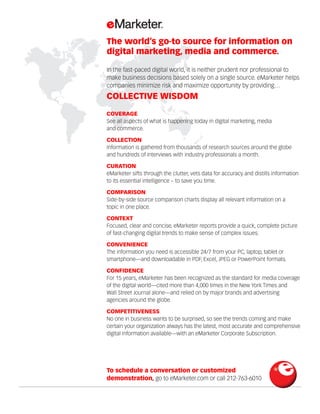This document discusses how the cost-per-thousand (CPM) pricing model for digital display advertising is evolving to incorporate performance metrics in response to brand advertisers' increasing focus on ROI. It explores how major publishers are offering both CPM and performance-based pricing, how programmatic buying enables dynamic CPMs, and how the push for viewable impressions may lead to viewable CPMs. Overall, the CPM model will still dominate but will grow more performance-conscious over time.








![OVERVIEW OF DIGITAL CPMS: MEASURES OF DIGITAL PERFORMANCE PLACE PRESSURE ON PRICING ©2013 EMARKETER INC. ALL RIGHTS RESERVED 9
UPHOLDING A CROSS-PLATFORM
COST STRUCTURE
Brands’ desire to benchmark their digital
advertising investment through both traditional
and digital-specific performance measures will only
grow as measurement and technology continue to
advance toward a more seamless cross-platform
advertising experience.
Though digital performance measures such as CPE or
CPA are likely to be used to justify the value of a CPM
price—and are currently offered by some publishers as
a pricing option—it is unlikely for brands to abandon a
standard pricing model such as a CPM.
“When you’re transacting billions of dollars onTV, and you
start moving the money in greater proportion into digital,
you’re not going to take on a different currency,” IAB’s
Mane said. “If display advertising is going to benefit from
having a common currency across platforms, it’ll have to
be the CPM.”
The Weather Channel’s Steinberg agreed, noting that
if there were another pricing model that was to be the
future of display, it would likely have already manifested
in more forward-looking areas, like RTB. “If there was
another business [pricing] model that made sense for
the marketplace, you’d see it already in programmatic,”
he said. “If you really want to scale a marketplace across
a wide variety of participants, the CPM seems like the
common currency.”
Still, publishers and other inventory providers will feel the
effects of a more performance-conscious and value-driven
brand marketer.
“If [publishers] don’t come up with innovative products or
units, they’re going to start to lose the conversation when
commanding premium pricing,” iCrossing’s Benson said.
Both interviews and data have suggested that publishers
and inventory providers seeking to improve their
performance and overall value would be rewarded
for their efforts. Financial services firm Credit Suisse
projected that by 2017, the average CPM for premium
display ad inventory in the US would be $12.70 and that
the average CPM for indirect inventory, which includes
programmatic, would reach $1.60—double what it was
in 2010.
US Online Display Ad CPM, by Inventory Tier, 2010-2017
2010
2011
2012
2013
2014
2015
2016
2017
Indirect
$0.80
$0.90
$1.00
$1.10
$1.20
$1.30
$1.50
$1.60
Midtier
$3.00
$2.90
$2.90
$2.80
$2.80
$2.70
$2.70
$2.60
Premium
$9.00
$9.50
$9.90
$10.40
$10.90
$11.50
$12.10
$12.70
Average CPM
$1.70
$1.70
$1.80
$1.90
$2.00
$2.20
$2.30
$2.50
Note: excludes mobile display ad impressions; average CPM calculated
using weighted average for online display ad impression share
Source: Credit Suisse, "Web 2.012," Feb 21, 2012
137412 www.eMarketer.com
Worth noting is that the firm estimated little growth in
CPM value for midtier inventory, defined as “lower-priced
inventory sold directly to advertisers.” Should industry
initiates such as the viewable CPM pricing model unfold,
one can expect much of the midtier inventory to either
be rendered obsolete or minimize in demand, perhaps
resulting in even lower estimates.
“As we evolve our measurement and evolve how we do
business, I do think there are factors that will help us get
higher CPMs on the digital side for the unique elements
of interactivity that enhance brand building,” Mane said.
“It’s not just an exposure in digital that will count, and
the sellers that are good at showing advertisers how this
activity builds brands will immediately goose up CPMs,
but only if they can prove that.”](https://image.slidesharecdn.com/emarketeroverviewofdigitalcpms-measuresofdigitalperformanceplacepressureonpricing-150522020358-lva1-app6892/85/E-marketer-overview_of_digital_cp_ms-measures_of_digital_performance_place_pressure_on_pricing-9-320.jpg)


